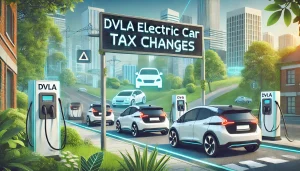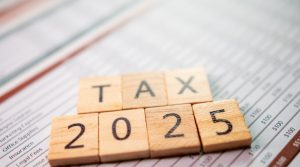The UK government is introducing significant updates to the Vehicle Excise Duty (VED) system from 1 April 2025, impacting electric, zero-emission, and low-emission vehicles.
These changes will bring the taxation of electric cars in line with petrol and diesel vehicles, marking a new era for vehicle ownership.
This blog unpacks the details of the new tax policies and their implications for drivers, focusing on the DVLA electric car tax changes.
What Are the DVLA Electric Car Tax Changes?

Starting from April 2025, the UK government will remove the tax exemption for electric vehicles (EVs), requiring them to pay Vehicle Excise Duty (VED) like petrol and diesel vehicles.
This change aims to align the tax framework across all vehicle types, ensuring fairness as the adoption of EVs continues to grow.
Previously classified under Band A, which carried a £0 rate, EVs will now move to taxable bands based on their registration date:
- Newly registered electric cars (post-2025): These vehicles will be subject to a £10 tax in the first year and £195 annually from the second year onwards.
- Previously registered EVs (2017–2025): These cars will incur a flat rate of £195 annually.
- Older EVs (2001–2017): Vehicles in this category will be taxed at £20 per year, maintaining affordability for older, less efficient electric models.
This transition highlights the government’s approach to balancing sustainability incentives with equitable taxation.
How Do the Changes Impact Hybrid and Alternative Fuel Vehicles?
Hybrid and alternatively fuelled vehicles (AFVs), once incentivised with tax discounts, will face similar revisions:
- Removal of the £10 annual discount: Hybrids and AFVs will no longer enjoy this minor benefit, which was initially intended to encourage their adoption.
- Vehicles registered before 1 April 2017: Tax rates for these vehicles will now depend on their CO2 emissions, aligning them with the broader tax framework for combustion engine vehicles.
- Vehicles registered after 1 April 2017: These vehicles will be taxed at the standard rate of £195 annually.
The removal of these incentives underscores the government’s focus on aligning all vehicle taxation with environmental impact and road usage.
For hybrid vehicle owners, this means carefully evaluating the overall cost of ownership.
What About Electric Vans and Motorcycles?

The changes also extend to electric vans, motorcycles, and tricycles, which were previously exempt from VED or taxed at lower rates.
Key adjustments include:
- Electric Vans: Moving to the standard annual rate for light goods vehicles, currently set at £290 per year. This change standardizes the tax framework for commercial and personal-use vans, regardless of their powertrain.
- Electric Motorcycles and Tricycles: These vehicles will now be taxed at the annual rate for the smallest engine size, currently £22.
These updates ensure that all vehicle types contribute fairly to the government’s tax revenue while acknowledging their road usage and environmental impact.
Luxury Car Supplement: How Will It Affect High-Value EVs?
High-value electric cars, with a list price exceeding £40,000, will be subject to the Expensive Car Supplement starting in 2025.
This tax will apply in addition to the standard rate, introducing the following costs:
- Annual fee: £410 for five years, starting from the second year of ownership.
- Scope: This applies to vehicles priced over £40,000, including optional extras added at the time of purchase.
The government has acknowledged that this supplement disproportionately affects EVs, as they typically have higher upfront costs than petrol or diesel equivalents.
However, no adjustments to the threshold have been announced yet. Drivers should carefully consider the total cost, including optional upgrades, as even a base-priced car could exceed the limit when extras are included.
For example, trims and options can push models like the Volkswagen ID.3 above £40,000.
Why Are These Changes Being Introduced?

The DVLA electric car tax changes reflect the evolving automotive market and the growing adoption of EVs.
As petrol and diesel vehicle sales decline ahead of the 2035 ban on new internal combustion engine vehicles, the government needs to maintain a steady revenue stream for road infrastructure.
Key reasons for the changes include:
- Revenue generation: With more drivers switching to EVs, the government aims to balance the reduction in fuel duty revenue by introducing consistent road tax across all vehicle types.
- Fairness: Equalizing the tax structure ensures that all vehicles contribute to road maintenance and infrastructure funding.
- Encouraging sustainable choices: While the changes may increase ownership costs, they are designed to support the long-term transition to zero-emission transport.
This policy update underscores the government’s commitment to sustainable transport while addressing financial and infrastructural challenges.
What Steps Should Drivers Take Before 2025?
To minimize the impact of these changes, drivers should take proactive steps:
Plan Finances
Include the new VED costs in your annual vehicle expenses. For those considering a high-value EV, factor in the luxury car supplement to avoid unexpected financial burdens.
Choose Wisely
Opt for EV models with a list price below £40,000 to avoid the Expensive Car Supplement. Popular options like the Kia e-Niro, Hyundai Ioniq 5, and Skoda Enyaq fall within this range but be cautious of optional extras that might push the price above the threshold.
Maximize Savings
- Use free charging points at supermarkets or workplaces to reduce fuel costs.
- Look for EV-specific electricity tariffs to lower home charging expenses.
- Take advantage of extended battery warranties offered by manufacturers like Nissan and Tesla.
Stay Updated
Regularly check DVLA updates and tax bands to ensure compliance and accurate financial planning. Drivers should also monitor government announcements for potential changes to tax rates or thresholds.
By taking these steps, EV owners can manage their costs effectively while continuing to enjoy the benefits of electric vehicles.
Conclusion
The DVLA electric car tax changes set to take effect in April 2025 mark a significant shift in vehicle ownership costs.
While these changes bring an end to tax exemptions for EVs, they highlight the government’s focus on equitable taxation and sustainable revenue generation.
Drivers should prepare for these updates by carefully selecting vehicles, planning finances, and taking advantage of available savings opportunities.
Despite the increased costs, EVs remain an environmentally friendly and cost-effective alternative to traditional petrol and diesel vehicles.





